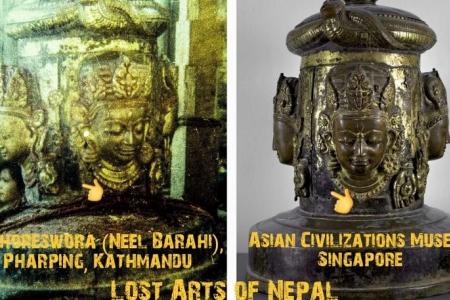Allegedly stolen Nepalese artefact acquired by S'pore museum through 'established procedures'
A Nepalese artefact at the Asian Civilisations Museum (ACM) that is alleged to have been stolen was acquired through the National Heritage Board's established procedures, a museum spokesman said.
Responding to queries from The Straits Times, he said on Wednesday (Aug 17) that the museum was aware of media reports claiming that the religious artwork depicting the Hindu deity Shiva had been looted.
ACM did not reply to questions on how the artwork had been obtained or at what cost.
He said: "The object in the reports is a copper Cover of a Linga, which was acquired by ACM in 2015 in accordance with the National Heritage Board's established procedures on acquisition. These procedures include evaluation by ACM's Acquisition Committee made up of external experts, as well as rigorous provenance checks carried out at the time of purchase, which are also benchmarked against international practices and regularly reviewed."
Lingas are abstract representations of Shiva, and metal linga covers have historically played a part in the worship of the god.
The ACM noted that the object is not listed in the Art Loss Register, which is the world's largest private database on stolen art.
Annually, the Art Loss Register checks the status of more than 400,000 items on the market for museums, auction houses, dealers and enforcement agencies.
Allegations that the artwork had been stolen in 1999 and traced to ACM first surfaced on Facebook page Lost Arts of Nepal on Sunday (Aug 14), according to Nepalese media including The Kathmandu Post.
The Facebook page describes itself as an initiative to make Nepalese citizens aware of their lost artistic heritage now available in museums and private collections abroad.
In a Facebook post on Sunday, it claimed that the artefact in the museum is one of four images of gods stolen from Pharping, a town on the edge of Kathmandu in Nepal.
The post claimed that the missing four artefacts had been used in religious rites involving seven deities before they were stolen and the ritual has since been conducted using replicas.
This is not the first time the ACM has been embroiled in controversy surrounding the origins of its artefacts.
In 2015, the museum returned an 11th-century bronze sculpture depicting the Hindu goddess Uma Parameshwari, dating back to the Chola dynasty, to Indian authorities after a series of discussions between the National Heritage Board and the Archaeological Survey of India.
While there is no conclusive proof that the sculpture was stolen from a Shiva temple in Tamil Nadu, India, the museum took note of the confession of Aaron Freedman, who was the manager of Art of the Past, of dealing in looted Indian antiquities and of criminal possession of 150 stolen objects, which included the sculpture, the museum said then.
The sculpture of the goddess was said to have been smuggled to the US, and in February 2007, sold by Kapoor to the Singapore museum for US$650,000 and shipped here.
The object was one of 30 that ACM had bought from the dealer between 1997 and 2010, all of them costing US$1,328,250.
The other 29 objects are not known to be registered as stolen artefacts, The Straits Times reported then.
Get The New Paper on your phone with the free TNP app. Download from the Apple App Store or Google Play Store now

